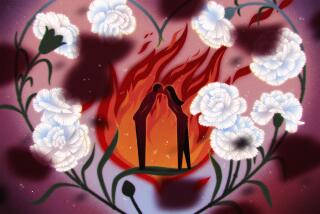It’s a new world, but are women that different now?
- Share via
EVERY generation has to endure the finger-wagging of the previous one. The warnings today’s baby boomer parents are sounding for their children inevitably circle back to the unfinished business of their own youth. This is especially true of mothers and daughters, with pep talks and cautionary tales shadowed by feminism’s legacy.
Young women will prove the old-school feminists right and have a successful career, a happy marriage and kids to boot. Or, if Washington Post reporter Laura Sessions Stepp’s forecast proves accurate, they’ll end up lonely, haunted by the “good” guys they traded for promiscuity and ambition. That is, unless they sober up, marry young(er) and maybe even practice religion. This is the essential wisdom that Stepp offers in “Unhooked: How Young Women Pursue Sex, Delay Love, and Lose at Both.”
“If there is a mantra that young women ... have heard repeatedly
Those values are what concern Stepp. “Hooking up” can mean having sex or just kissing but it is rarely an act of emotional intimacy or commitment for young women. And this is at the crux of Stepp’s concern: “[W]ho, I wondered, was telling them that they were worth taking more care with -- that they deserved to take care with themselves and insist that boys take care with them, too?”
Stepp interviewed dozens of young women, then focused on nine moderately affluent ones from high schools in the Washington, D.C., area as well as Duke and George Washington universities. These young women are smart, high achievers, which, it is presumed, make their promiscuous behavior all the more disturbing. Stepp followed them to class and bars, noting as they danced on tables and made out in dark corners. And her subjects gamely shared their diary entries, e-mails and instant-message exchanges, their bad sex and bad behavior.
Names were changed, freeing subjects to speak with breathtaking, and, at times, off-putting, candor. A 15-year-old, with her mother by her side, explained that she and her friends perform oral sex on the boys in their class -- and then decide if they like them. College women, meanwhile, talked of choosing drunken one-night stands over boyfriends and often referenced their conquests with rage-filled disdain. It’s sometimes compelling and certainly voyeuristic, but Stepp gives the melodramas too much space and perhaps too much gravity, making the book read like an MTV reality show.
Stepp’s message -- that promiscuity is more exaggerated than in the past and that young women need more guidance on healthy relationships -- is important. But, with her sample group, can she really make such broad societal conclusions? These girls are just experimenting, just as every generation of women before them. She does present a slew of statistics to back up her thesis, showing that women are having more sex at younger ages, are less interested in commitments and aspire to marry later. She links hooking up to rising rates of sexually transmitted diseases and date rape (logical conclusions) but also blames it for anorexia and increased rates of depression on college campuses (not so much). Her retro notions of how young women should behave color all.
Stepp suggests young women bake cookies and brownies instead of trawling for men at bars. “Guys will do anything for homemade baked goods,” she writes. And while many young women say they want to be married, “if current trends hold, they’ll be in their late twenties or early thirties before they marry, and most will continue to work at least part time.” That’s a problem?
While Stepp’s concern is justified in some cases, much of her rhetoric illustrates the growing generation gap between baby boomers and young adults. In many ways, technology has so accelerated experience that there’s little room for common ground. And there’s some nostalgia at work here too. Stepp wistfully recalls the “old fashioned dating” of her youth without dwelling on the free love and partner-swapping that also characterized the time.
While Stepp finds a potentially harmful trend among upwardly mobile young people, she has overstated the possible disaster here. Promiscuity among 14-year-olds is one (very troubling) thing. But promiscuity among college kids is par for the course. Just because they talk about it more or in coarser terms than Stepp’s peers did 30 years ago doesn’t mean they’re doomed to spinsterhood. Growing up has always been rife with uncertainty and embarrassing mistakes. Each generation develops new ways of coping. These high achievers will, no doubt, find their own.
*
More to Read
Sign up for Essential California
The most important California stories and recommendations in your inbox every morning.
You may occasionally receive promotional content from the Los Angeles Times.









